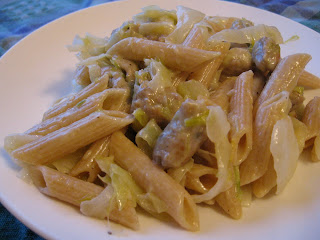I haven’t been posting lately, but I’ve definitely been eating. And fall meals are so delicious. It might be my favorite eating season. We’ve been feasting on Roasted Pumpkin Penne with Autumn Pesto, Butternut Squash Risotto with Pancetta, Eggplant “Meatballs” with Arugula and Shaved Fennel Salad. And Trevor has been making his own salad mix with numerous spicy winter greens.
The fall vegetable from Persephone Farm that we’ve been enjoying the most is one that many people hate: Brussels sprouts. When I posted on Facebook about the delectable Brussels sprouts we’d had for dinner, I got a firestorm of responses. A few people could not believe we found them tasty. But most of my friends professed their love for the cruciferous vegetable.
I think they’ve gotten a bad rap because if they are overcooked they can be downright hideous. I actually never ate them growing up because my mom hated them! I only tried them a few years ago when Trevor brought home a big stalk after his shift at the Farmers’ Market. But treated right, they are splendid!
We followed a recipe from Sheila Lukins and Julee Rosso’s New Basics cookbook. It called for the leaves to be pulled from the Brussels sprouts and lightly sautéed in butter, olive oil and thyme. We’ve found that quartering the sprouts and cutting out the core saves a lot of time and lets plenty of leaves get separated. Which means some of the leaves get a little crispy and brown, and that's the best part.
Other suggestions: Roast in the oven with olive oil, sautée with garlic, crisp up some pancetta then sauté leaves in drippings and add crumbled pancetta to each serving.
Of course, other parts of the meal are important. With my Brussels sprouts I made, a Pancetta Wrapped Pork Roast from a Martha Stewart recipe and some roasted acorn squash also from Persephone Farm. It so good, I made the same meal again a few weeks later for my friend Maureen’s birthday.
So if you have shunned Brussels sprouts in the past, I say put aside old prejudices and give them a second chance. You might discover your new favorite vegetable.
Links:
Pancetta Wrapped Pork Roast

































